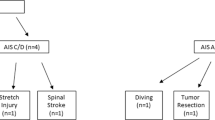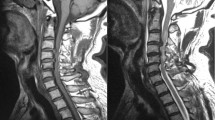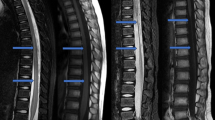Abstract
Study Design:
Case report.
Objective:
To describe the mechanism of injury in this case and its clinical features. Magnetic resonance (MR) images of hemorrhage in spinal cord injury due to stab wound are discussed.
Methods:
We describe the case of a 21-year-old woman who was stabbed in the right side of her neck and developed left-sided Brown–Séquard syndrome plus loss of bilateral proprioceptive sensation. Neither plain radiographs nor computed tomography of the cervical spine demonstrated any foreign bodies or fractures of the cervical spine. T2-weighted cervical MR images confirm spinal cord hemiresection at C5–C6.
Results:
MR imaging was performed serially at 4 days, 4 weeks, and 8 weeks after trauma. The signal pattern of the spinal cord at the site of injury varied iso, iso, and low on T1-weighted consecutive images. Meanwhile, high signal intensity on T2-weighted images was consistent during the 8 weeks after incidence of trauma. A T2-weighted sagittal image showed a tiny spot of low intensity in the high signal band at the site of penetration, demonstrating hemosiderin formation in the spinal cord. The patient was treated conservatively and, recovered from Frankel grade C to grade D.
Conclusion:
Spinal cord injuries (SCI) following stab wounds are rare. MR imaging is definitely useful for recording and monitoring the pathology of SCI.
Similar content being viewed by others
Log in or create a free account to read this content
Gain free access to this article, as well as selected content from this journal and more on nature.com
or
References
Lipschitz R, Block J . Stab wounds of the spinal cord. Lancet 1962; 2: 169–172.
Peacock WJ, Shrosbree RD, Key AG . A review of 450 stabwounds of the spinal cord. S Afr Med J 1977; 51: 961–964.
Waters RL, Sie I, Adkins RH, Yakura JS . Motor recovery following spinal cord injury caused by stab wounds: a multicenter study. Paraplegia 1995; 33: 98–101.
Koehler PJ, Endtz LJ . The Brown–Sequard syndrome. True or false? Arch Neurol 1986; 43: 921–924.
Hackney DB et al. Hemorrhage and edema in acute spinal cord compression: demonstration by MR imaging. Radiology 1986; 161: 387–390.
Alkan A, Baysal T, Saras K, Sigirci A, Kutlu R . Early MRI findings in stab wound of the cervical spine: two case reports. Neuroradiology 2002; 44: 64–66.
Bondurant FJ et al. Acute spinal cord injury. A study using physical examination and magnetic resonance imaging. Spine 1990; 15: 161–168.
Kulkarni AV et al. Delayed presentation of spinal stab wound: case report and review of the literature. J Emerg Med 2000; 18: 209–213.
Frankel HL et al. The value of postural reduction in the initial management of closed injuries of the spine with paraplegia and tetraplegia. I. Paraplegia 1969; 7: 179–192.
Taylor RG, Gleave JRW . Incomplete spinal cord injuries with Brown–Sequard phenomena. J Bone Joint Surg 1957; 39-B: 438–450.
Bradley Jr WG . MR appearance of hemorrhage in the brain. Radiology 1993; 189: 15–26.
Anzalone N, Scotti R, Riva R . Neuroradiologic differential diagnosis of cerebral intraparenchymal hemorrhage. Neurol Sci 2004; 25 (Suppl 1): S3–S5.
Rubin G, Tallman D, Sagan L, Melgar M . An unusual stab wound of the cervical spinal cord: a case report. Spine 2001; 26: 444–447.
Simpson Jr RK, Venger BH, Narayan RK . Treatment of acute penetrating injuries of the spine: a retrospective analysis. J Trauma 1989; 29: 42–46.
Author information
Authors and Affiliations
Rights and permissions
About this article
Cite this article
Takemura, S., Sasai, K., Ohnari, H. et al. Brown–Séquard-plus syndrome due to stab injury: a case report. Spinal Cord 44, 518–521 (2006). https://doi.org/10.1038/sj.sc.3101871
Published:
Issue date:
DOI: https://doi.org/10.1038/sj.sc.3101871
Keywords
This article is cited by
-
Pediatric arrowshot injury to cervical spinal cord-sagittal cord transection with no neurological deficit and good outcome: case report and review of literature
Child's Nervous System (2013)
-
The role of MRI in spinal stab wounds compared with intraoperative findings
European Spine Journal (2012)



